Process Effluent Recycling in the Supercritical Water Gasification of Dry Biomass
Abstract
:1. Introduction
2. Materials and Methods
2.1. Preparation of Educts
2.2. Apparatus
2.3. Analysis
2.4. Data Interpretation
3. Results and Discussion
3.1. Gasification of Reed Canary Grass
3.2. Gasification of Grapevines
3.3. Separation of Salts
3.4. Formation of Solid Deposits
3.5. Estimation of Water Savings through Effluent Recycling
4. Conclusions
Author Contributions
Funding
Data Availability Statement
Acknowledgments
Conflicts of Interest
References
- Kaltschmitt, M.; Hartmann, H.; Hofbauer, H. Energie aus Biomasse, 2nd ed.; Springer: Heidelberg, Germany, 2009; ISBN 978-3-540-85094-6. [Google Scholar]
- Kruse, A.; Dinjus, E. Hot compressed water as reaction medium and reactant properties and synthesis reactions. J. Supercrit. Fluids 2007, 39, 362–380. [Google Scholar] [CrossRef]
- Wang, S.; Xu, D.; Guo, Y. Supercritical Water Processing Technologies for Environment, Energy and Nanomaterial Applications; Springer Nature: Singapore, 2020; ISBN 978-981-13-9325-9. [Google Scholar]
- Boukis, N.; Galla, U.; Müller, H.; Dinjus, E. Biomass Gasification in Supercritical Water. Experimental progress achieved with the VERENA pilot plant. In Proceedings of the 15th European Biomass Conference & Exhibition, Berlin, Germany, 7–11 May 2007. [Google Scholar]
- Yakaboylu, O.; Harnick, J.; Smit, K.G.; Jong, W. Supercritical Water Gasification of Biomass: A Literature and Technology Overview. Energies 2015, 8, 859–894. [Google Scholar] [CrossRef]
- Castello, D.; Kruse, A.; Fiori, L. Supercritical Water Gasification of Glucose/Phenol Mixtures as Model Compounds for Ligno-Cellulosic Biomass. Chem. Eng. Trans. 2014, 37, 193–198. [Google Scholar] [CrossRef]
- Boukis, N.; Diem, V.; Dinjus, E.; Galla, U.; Kruse, A. Biomass Gasification in Supercritical Water. In Proceedings of the 12th European Conference on Biomass for Energy, Industry and Climate Protection, Amsterdam, The Netherlands, 17–21 June 2002. [Google Scholar]
- Demirbas, A. Hydrogen-rich gas from fruit shells via supercritical water extraction. Int. J. Hydrog. Energy 2004, 29, 1237–1243. [Google Scholar] [CrossRef]
- Boukis, N.; Galla, U.; Diem, V.; D’Jesus, P.; Dinjus, E. Hydrogen production from biomass in supercritical water. In Proceedings of the H2-Age: When, Where, Why, Pisa, Italy, 16–19 May 2004. [Google Scholar]
- Resende, F.L.P.; Savage, P.E. Kinetic Model for Noncatalytic Supercritical Water Gasification of Cellulose and Lignin. AIChE J. 2010, 56, 2412–2420. [Google Scholar] [CrossRef]
- Guan, Q.; Wei, C.; Savage, P.E. Kinetic model for supercritical water gasification of algae. Phys. Chem. Chem. Phys. 2012, 14, 3140–3147. [Google Scholar] [CrossRef]
- Waldner, M.H.; Vogel, F. Renewable Production of Methane from Woody Biomass by Catalytic Hydrothermal Gasification. Ind. Eng. Chem. Res. 2005, 44, 4543–4551. [Google Scholar] [CrossRef]
- Kruse, A.; Funke, A.; Titirici, M. Hydrothermal conversion of biomass to fuels and energetic materials. Curr. Opin. Chem. Biol. 2013, 17, 515–521. [Google Scholar] [CrossRef]
- Susanti, R.F.; Veriansyah, B.; Kim, J.-D.; Kim, J.; Lee, Y.-W. Continuous supercritical water gasification of isooctane: A promising reactor design. Int. J. Hydrog. Energy 2010, 35, 1957–1970. [Google Scholar] [CrossRef]
- Boukis, N.; Stoll, I.K. Gasification of Biomass in Supercritical Water, Challenges for the Process Design—Lessons Learned from the Operation Experience of the First Dedicated Pilot Plant. Processes 2021, 9, 455. [Google Scholar] [CrossRef]
- Boukis, N.; Galla, U.; D’Jesús, P.; Müller, H.; Dinjus, E. Gasification of wet biomass in supercritical water. Results of pilot plant experiments. In Proceedings of the 14th European Biomass Conference for Energy, Industry and Climate Protection, Paris, France, 17–21 October 2005. [Google Scholar]
- Gadhe, J.B.; Gupta, R.B. Hydrogen Production by Methanol Reforming in Supercritical Water: Suppression of Methane Formation. Ind. Eng. Chem. Res. 2005, 44, 4577–4585. [Google Scholar] [CrossRef]
- Savage, P.E. A perspective on catalysis in sub- and supercritical water. J. Supercrit. Fluids 2009, 47, 407–414. [Google Scholar] [CrossRef]
- Kruse, A. Supercritical water gasification. Biofuels Bioprod. Bioref. 2008, 2, 415–437. [Google Scholar] [CrossRef]
- Boukis, N.; Galla, U. Verfahren zur hydrothermalen Vergasung von Biomasse in überkritischem Wasser. Forschungszentrum Karlsruhe GmbH, 76133 Karlsruhe, Germany. 2006 044 116 B3, 30 April 2008. [Google Scholar]
- Schubert, M.; Regler, J.W.; Vogel, F. Continuous salt precipitation and separation from supercritical water. Part 1: Type 1 salts. J. Supercrit. Fluids 2010, 52, 99–112. [Google Scholar] [CrossRef]
- Castello, D. Supercritical Water Gasification of Biomass. Ph.D. Thesis, University of Trento, Trento, Italy, 2013. [Google Scholar]
- Armellini, F.J. Phase Equilibria and Precipitation Phenomena of Sodium Chloride and Sodium Sulfate in Sub- and Supercritical Water. Ph.D. Thesis, Massachusetts Institute of Technology, Cambridge, MA, USA, 1993. [Google Scholar]
- Kruse, A. Hydrothermal biomass gasification. J. Supercrit. Fluids 2009, 47, 391–399. [Google Scholar] [CrossRef]
- Boukis, N.; Stoll, I.K.; Sauer, J.; Fischer, J.; Kansy, R. Separation of Salts During the Gasification of Spent Grain in Supercritical Water. In Proceedings of the 25th European Biomass Conference and Exhibition, Stockholm, Sweden, 12–15 June 2017. [Google Scholar]
- D’Jesus, P. Die Vergasung von realer Biomasse in überkritischem Wasser: Untersuchung des Einflusses von Prozessvariablen und Edukteigenschaften. Ph.D. Thesis, Universität Karlsruhe, Karlsruhe, Germany, 2007. [Google Scholar]
- Yan, M.; Liu, Y.; Song, Y.; Xu, A.; Zhu, G.; Jiang, J.; Hantoko, D. Comprehensive experimental study on energy conversion of household kitchen waste via integrated hydrothermal carbonization and supercritical water gasification. Energy 2022, 242, 123054. [Google Scholar] [CrossRef]
- Di Fraia, A.; Miliotti, E.; Rizzo, A.M.; Zoppi, G.; Pipitone, G.; Pirone, R.; Rosi, L.; Chiaramonti, D.; Bensaid, S. Coupling hydrothermal liquefaction and aqueous phase reforming for integrated production of biocrude and renewable H2. AIChE J. 2023, 69, e17652. [Google Scholar] [CrossRef]
- Zoppi, G.; Pipitone, G.; Pirone, R.; Bensaid, S. Aqueous phase reforming process for the valorization of wastewater streams: Application to different industrial scenarios. Catal. Today 2022, 387, 224–236. [Google Scholar] [CrossRef]
- Lord, R.A. Reed canarygrass (Phalaris arundinacea) outperforms Miscanthus or willow on marginal soils, brownfield and non-agricultural sites for local, sustainable energy crop production. Biomass Bioenergy 2015, 78, 110–125. [Google Scholar] [CrossRef] [Green Version]
- Sinag, A.; Kruse, A.; Schwarzkopf, V. Key Compounds of the Hydropyrolysis of Glucose in Supercritical Water in the Presence of K2CO3. Ind. Eng. Chem. Res. 2003, 42, 3516–3521. [Google Scholar] [CrossRef]
- Sinag, A.; Kruse, A.; Rathert, J. Influence of the Heating Rate and the Type of Catalyst on the Formation of Key Intermediates and on the Generation of Gases During Hydropyrolysis of Glucose in Supercritical Water in a Batch Reactor. Ind. Eng. Chem. Res. 2004, 43, 502–508. [Google Scholar] [CrossRef]
- Zhu, Z.; Toor, S.S.; Rosendahl, L.A.; Yu, D.; Chen, G. Influence of alkali catalyst on product yield and properties via hydrothermal liquefaction of barley straw. Energy 2015, 80, 284–292. [Google Scholar] [CrossRef]
- Nanda, S.; Gong, M.; Hunter, H.N.; Dalai, A.K.; Gökalp, I.; Kozinski, J.A. An assessment of pinecone gasification in subcritical, near-critical and supercritical water. Fuel Process. Technol. 2017, 168, 84–96. [Google Scholar] [CrossRef]
- Okolie, J.A.; Rana, R.; Nanda, S.; Dalai, A.K.; Kozinski, J.A. Supercritical water gasification of biomass: A state-of- the-art review of process parameters, reaction mechanisms and catalysis. Sustain. Energy Fuels 2019, 3, 578–598. [Google Scholar] [CrossRef]
- Nanda, S.; Reddy, S.N.; Hunter, H.N.; Dalai, A.K.; Kozinski, J.A. Supercritical water gasification of fructose as a model compound for waste fruits and vegetables. J. Supercrit. Fluids 2015, 104, 112–121. [Google Scholar] [CrossRef]
- Lu, Y.; Guo, L.; Zhang, X.; Hao, X.; Yan, Q. Hydrogen production by biomass gasification in supercriticalwater: A parametric study. Int. J. Hydrog. Energy 2006, 31, 822–831. [Google Scholar] [CrossRef]
- Wang, C.; Du, M.; Feng, H.; Jin, H. Experimental investigation on biomass gasification mechanism in supercritical water for poly-generation of hydrogen-rich gas and biochar. Fuel 2022, 319, 123809. [Google Scholar] [CrossRef]
- D’Jesus, P.; Boukis, N.; Kraushaar-Czarnetski, B.; Dinjus, E. Influence of Process Variables on Gasification of Corn Silage in Supercritical Water. Ind. Eng. Chem. Res. 2006, 45, 1622–1630. [Google Scholar] [CrossRef]
- Hodes, M.; Marrone, P.A.; Hong, G.T.; Smith, K.A.; Tester, J.W. Salt precipitation and scale control in supercritical water oxidation—Part A. Fundamentals and research. J. Supercrit. Fluids 2004, 29, 265–288. [Google Scholar] [CrossRef]
- Kritzer, P.; Boukis, N.; Dinjus, E. Factors controlling corrosion in high-temperature aqueous solutions. A contribution to the dissociation and solubility data influencing corrosion processes. J. Supercrit. Fluids 1999, 15, 205–227. [Google Scholar] [CrossRef]
- Boukis, N.; Habicht, W.; Hauer, E.; Weiss, K.; Dinjus, E. Corrosion Behavior of Ni-Base Alloys and Stainless Steels in Supercritical Water Containing Potassium Hydrogen Carbonate. In Proceedings of the EUROCORR 2008: The European Corrosion Congress, Edinburgh, UK, 7 September 2008. [Google Scholar]
- Loppinet-Serani, A.; Aymonier, C.; Cansell, F. Current and Foreseeable Applications of Supercritical Water for Energy and the Environment. ChemSusChem 2008, 1, 486–503. [Google Scholar] [CrossRef]
- Schubert, M. Catalytic hydrothermal gasification of biomass—Salt recovery and continous gasifiaction of glycerol solutions. Ph.D. Thesis, Eidgenössische Technische Hochschule Zürich, Zurich, Switzerland, 2010. [Google Scholar]
- Valyashko, V. Phase behaviour in binary and ternary water-salt systems at high temperatures and pressures. Pure Appl. Chem. 1997, 69, 2271–2280. [Google Scholar] [CrossRef]
- Weingärtner, H.; Franck, E.U. Überkritisches Wasser als Lösungsmittel. Angew. Chem. 2005, 117, 2730–2752. [Google Scholar] [CrossRef]
- Ekpo, U.; Ross, A.B.; Camargo-Valero, M.A.; Williams, P.T. A comparison of product yields and inorganic content in process streams following thermal hydrolysis and hydrothermal processing of microalgae, manure and digestate. Bioresour. Technol. 2016, 200, 951–960. [Google Scholar] [CrossRef]
- Zhao, L.; Zhang, J.; Sheng, C.D.; Wang, K.; Ding, Q.Z. Dissolution Characteristics of Inorganic Elements Existing in Biomass during the Supercritical Water Gasification Process. Energy Sources Part A: Recovery Util. Environ. Eff. 2012, 34, 1893–1900. [Google Scholar] [CrossRef]
- Yanagida, T.; Minowa, T.; Nakamura, A.; Matsumura, Y.; Noda, Y. Behavior of Inorganic Elements in Poultry Manure during Supercritical Water Gasification. J. Jpn. Inst. Energy 2008, 87, 731–736. [Google Scholar] [CrossRef] [Green Version]
- Chuntanapum, A.; Matsumura, Y. Char Formation Mechanism in Supercritical Water Gasification Process: A Study of Model Compounds. Ind. Eng. Chem. Res. 2010, 49, 4055–4062. [Google Scholar] [CrossRef]
- Guo, L.J.; Lu, Y.J.; Zhang, X.M.; Ji, C.M.; Guan, Y.; Pei, A.X. Hydrogen production by biomass gasification in supercritical water: A systematic experimental and analytical study. Catal. Today 2007, 129, 275–286. [Google Scholar] [CrossRef]
- Reddy, S.N.; Nanda, S.; Dalai, A.K.; Kozinski, J.A. Supercritical water gasification of biomass for hydrogen production. Int. J. Hydrog. Energy 2014, 39, 6912–6926. [Google Scholar] [CrossRef]
- Romero-Anaya, A.J.; Ouzzine, M.; Lillo-Rodenas, M.A.; Linares-Solano, A. Spherical carbons: Synthesis, characterization and activation processes. Carbon 2014, 68, 296–307. [Google Scholar] [CrossRef]
- Mwenya, T.; Fan, H.; Dai, H.; Li, M. The Detailed Evolution of Carbon Spheres by Hydrothermal Method. Int. J. Photoenergy 2016, 2016, 9057418. [Google Scholar] [CrossRef] [Green Version]
- Sun, X.; Li, Y. Hollow carbonaceous capsules from glucose solution. J. Colloid Interface Sci 2005, 291, 7–12. [Google Scholar] [CrossRef] [PubMed]
- Sun, X.; Li, Y. Colloidal Carbon Spheres and Their Core/Shell Structures with Noble-Metal Nanoparticles. Angew. Chem. Int. Ed. 2004, 43, 597–601. [Google Scholar] [CrossRef] [PubMed]
- Li, M.; Li, W.; Liu, S. Hydrothermal synthesis, characterization, and KOH activation of carbon spheres from glucose. Carbohydr. Res. 2011, 346, 999–1004. [Google Scholar] [CrossRef]
- LaMer, V.; Dinegar, R.H. Theory, Production and Mechanism of Formation of Monodispersed Hydrosols. J. Am. Chem. Soc. 1950, 72, 4847–4854. [Google Scholar] [CrossRef]
- Chen, S.; Tang, K.; Song, F.; Liu, Z.; Zhang, N.; Lan, S.; Xie, X.; Wu, Z. Porous hard carbon spheres derived from biomass for high-performance sodium/potassium-ion batteries. Nanotechnology 2002, 33, 055401. [Google Scholar] [CrossRef]
- Qi, X.; Lian, Y.; Yan, L.; Smith, R.L., Jr. One-step preparation of carbonaceous solid acid catalysts by hydrothermal carbonization of glucose for cellulose hydrolysis. Catal. Commun. 2014, 57, 50–54. [Google Scholar] [CrossRef]
- Wang, Q.; Li, H.; Chen, L.; Huang, X. Monodispersed hard carbon spherules with uniform nanopores. Carbon 2001, 39, 2211–2214. [Google Scholar] [CrossRef]
- Zheng, M.; Liu, Y.; Xiao, Y.; Zhu, Y.; Guan, Q.; Yuan, D.; Zhang, J. An Easy Catalyst-Free Hydrothermal Method to Prepare Monodisperse Carbon Microspheres on a Large Scale. J. Phys. Chem. C 2009, 113, 8455–8459. [Google Scholar] [CrossRef]
- Boukis, N.; Hauer, E.; Habicht, W. Corrosion Behaviour of Ni-Base Alloys in Supercritical Water Containing Alkali Chlorides. In Proceedings of the EUROCORR 2013: The European Corrosion Congress, Estoril, Portugal, 2 September 2013. [Google Scholar]

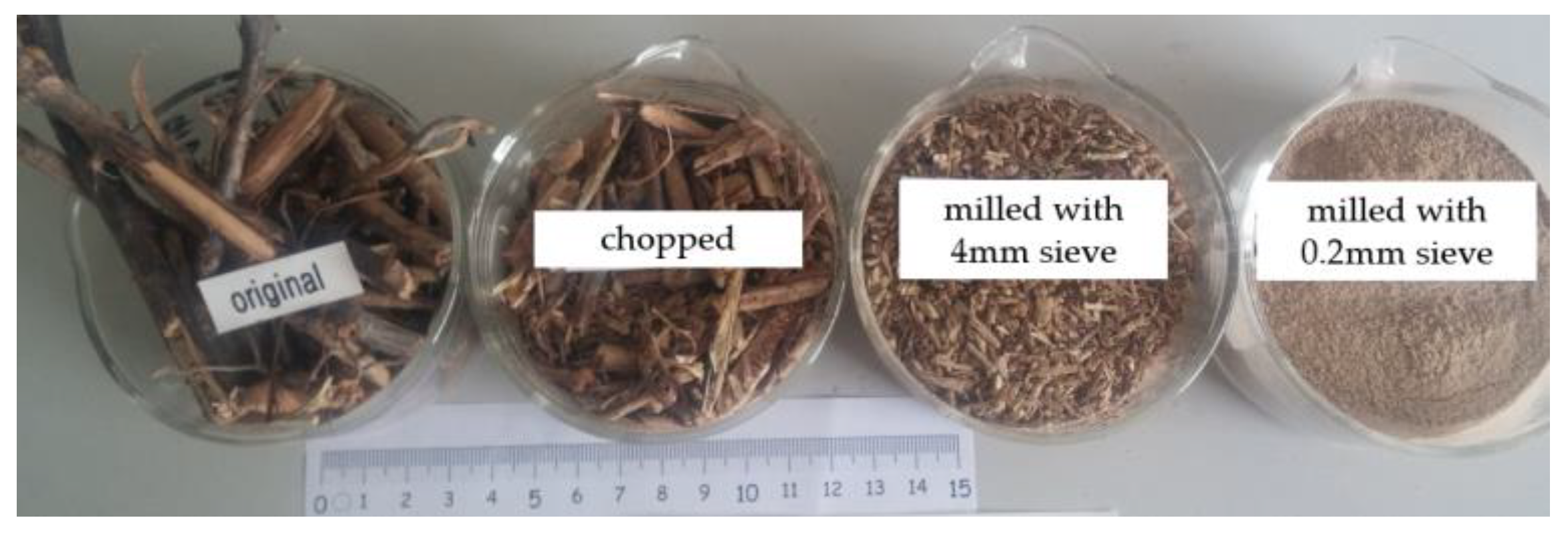
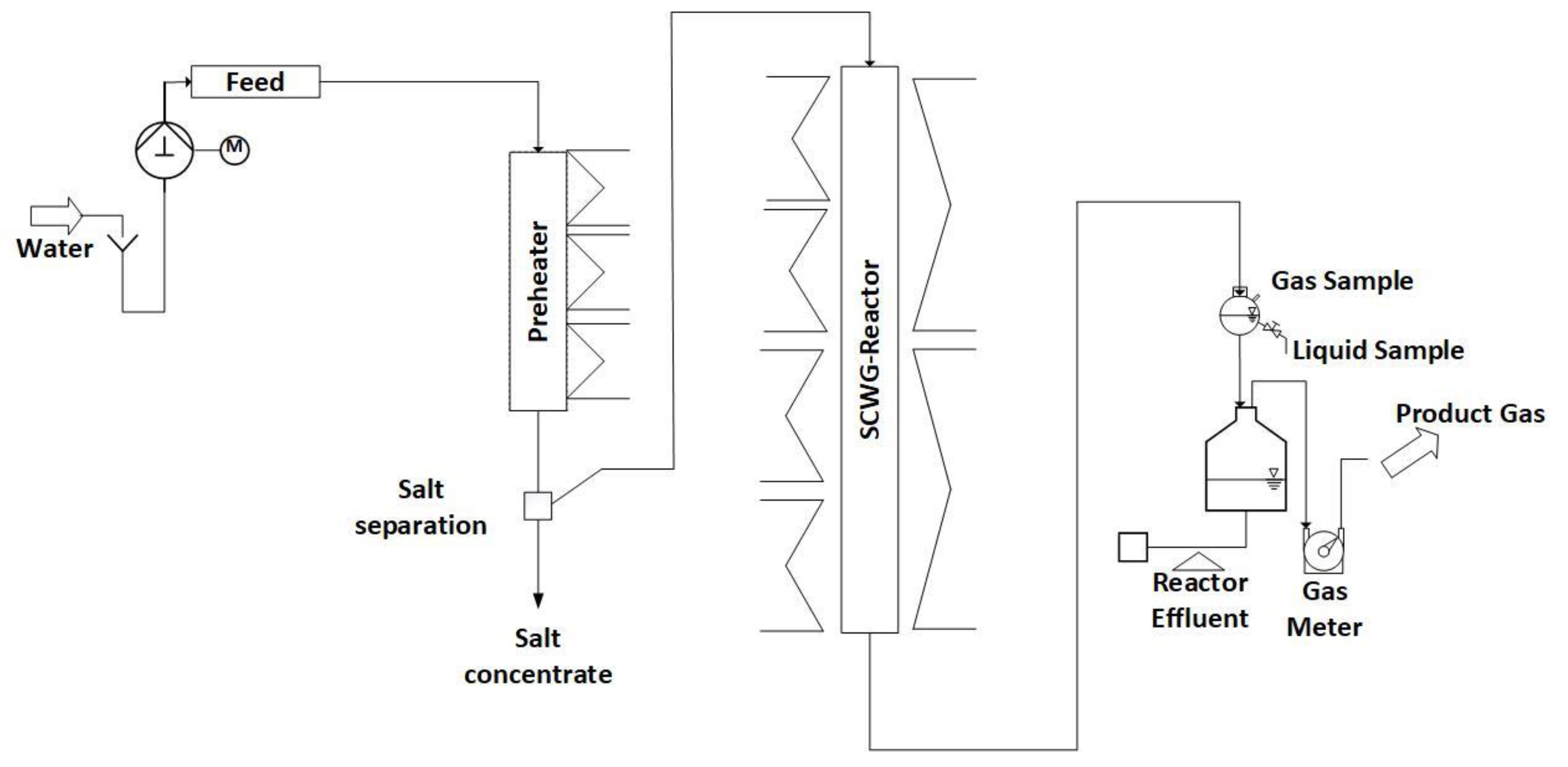

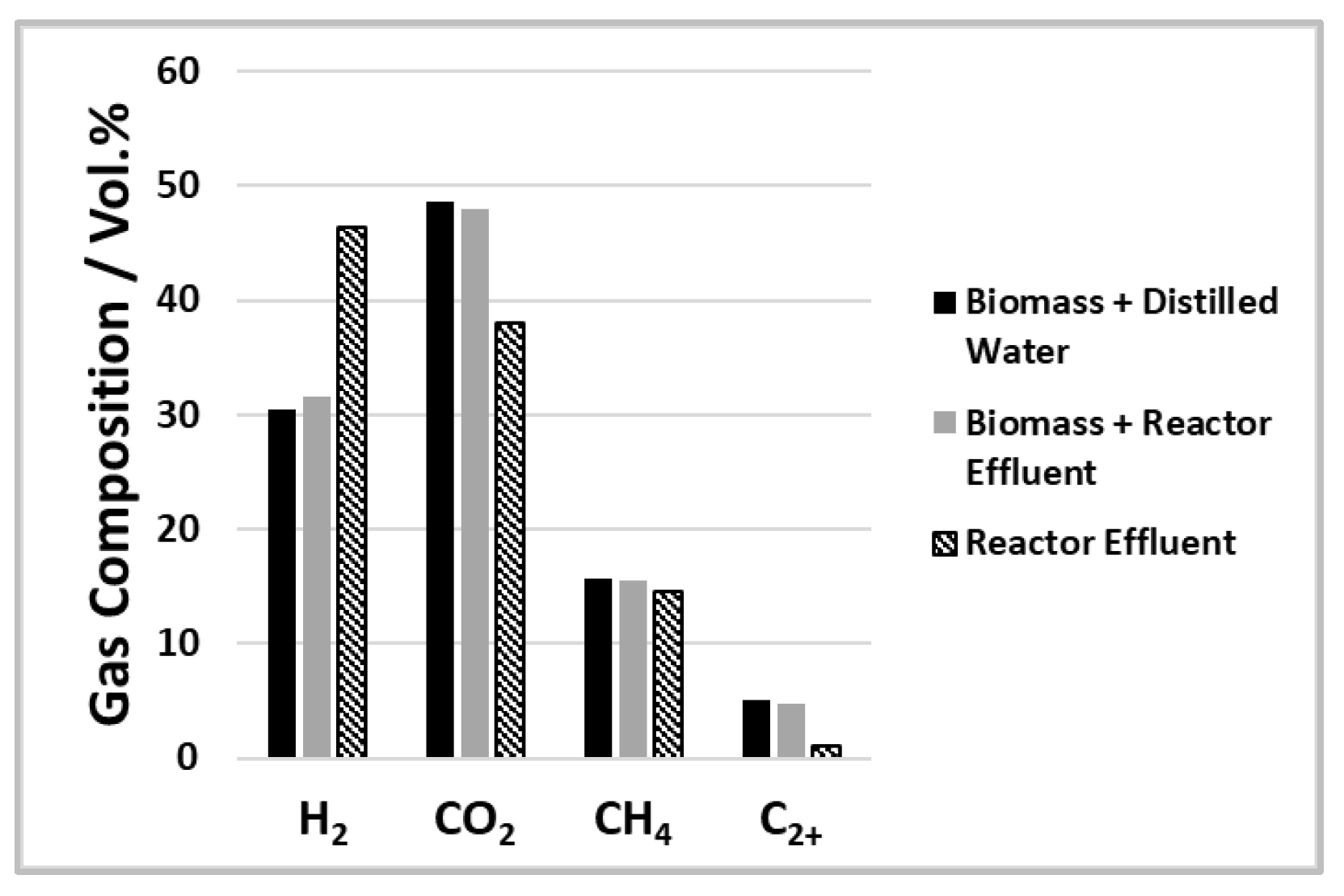
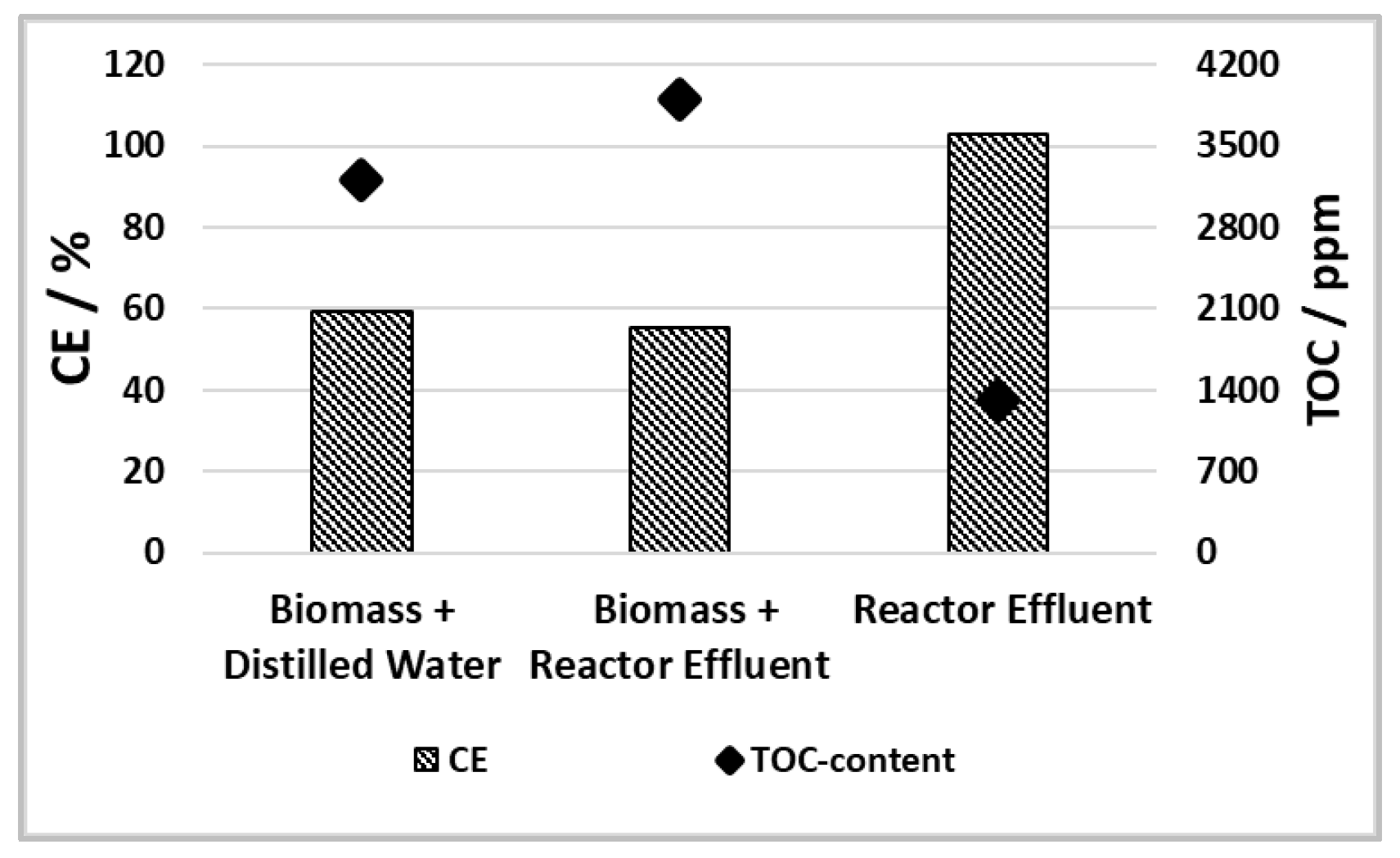

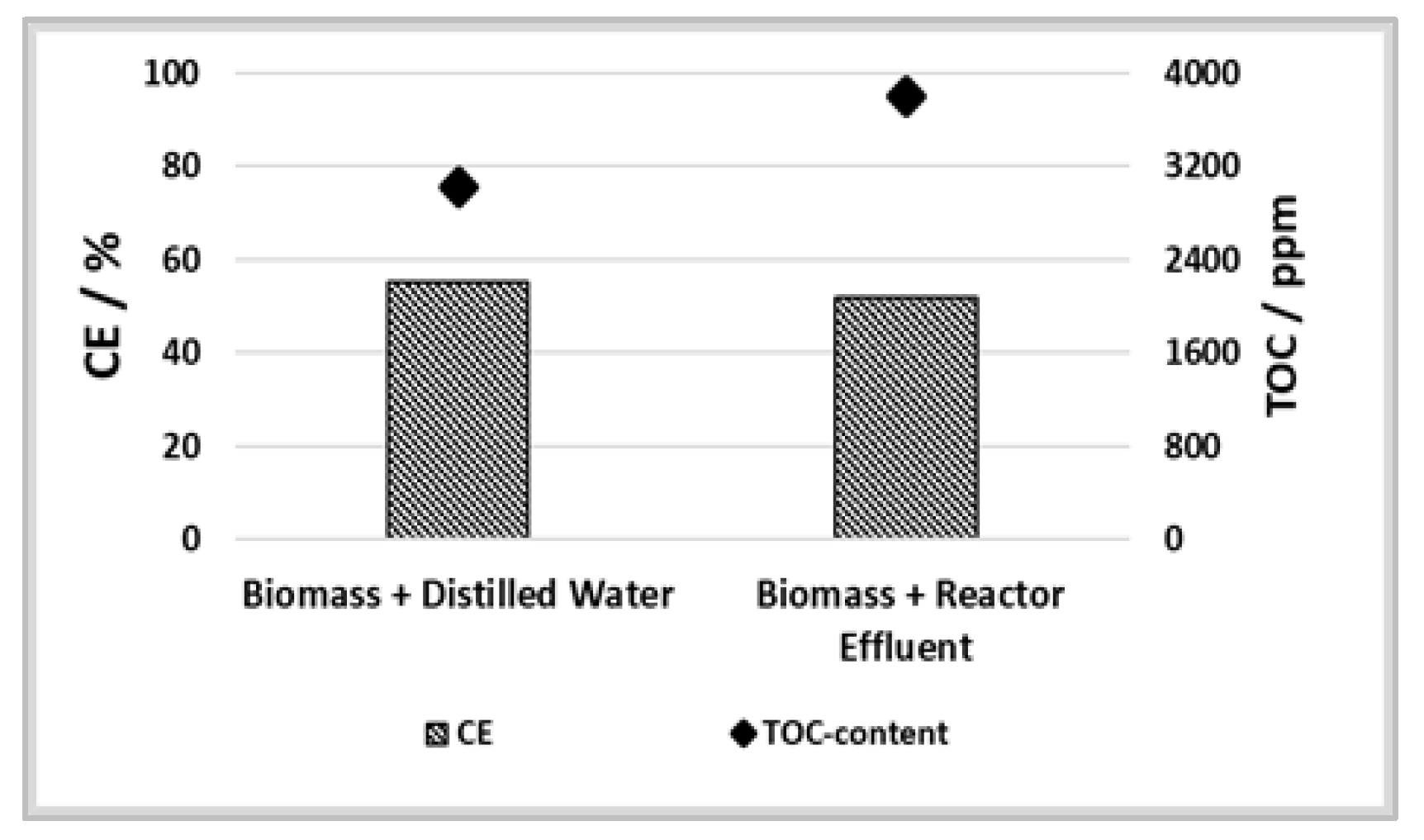


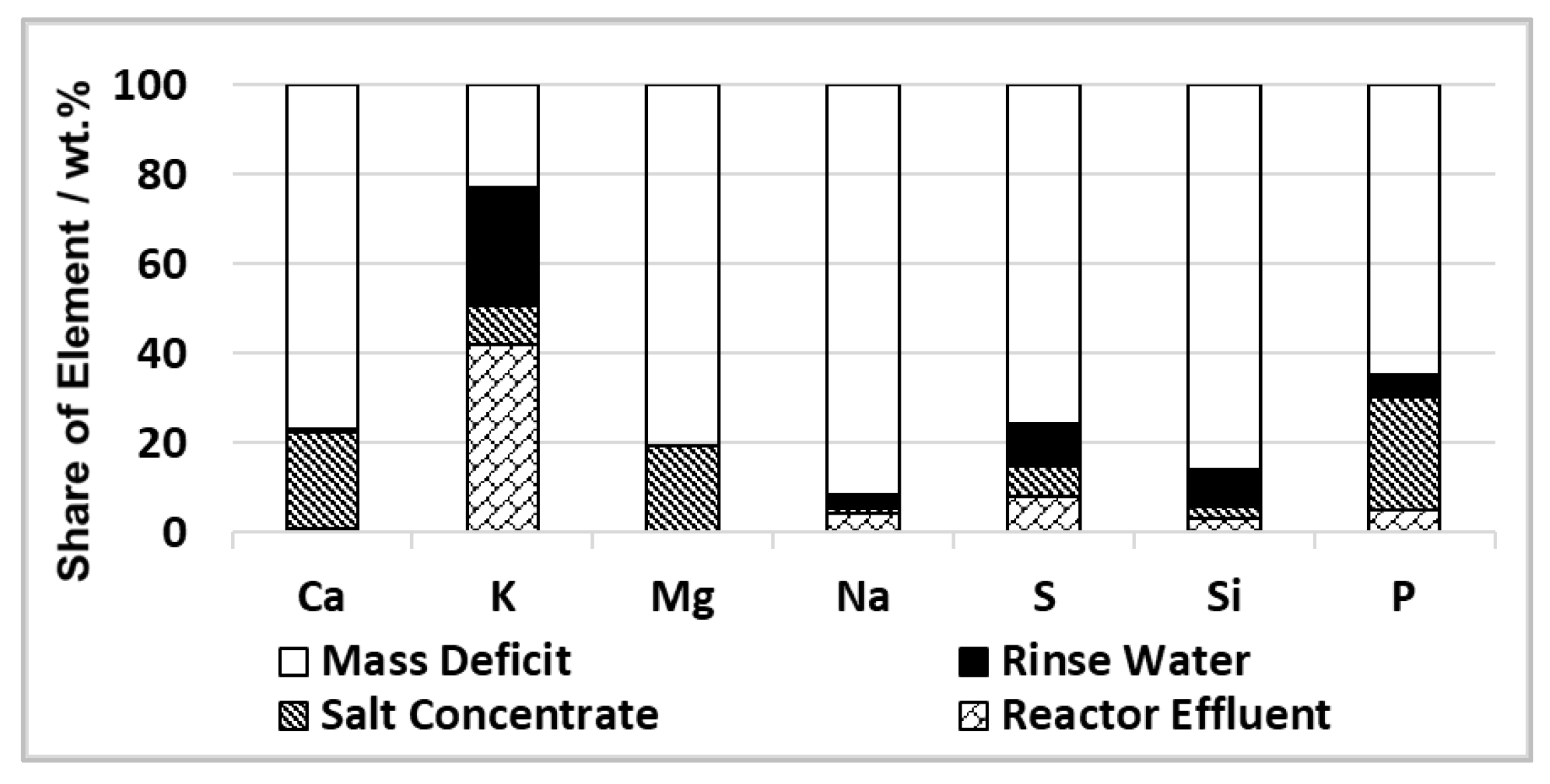
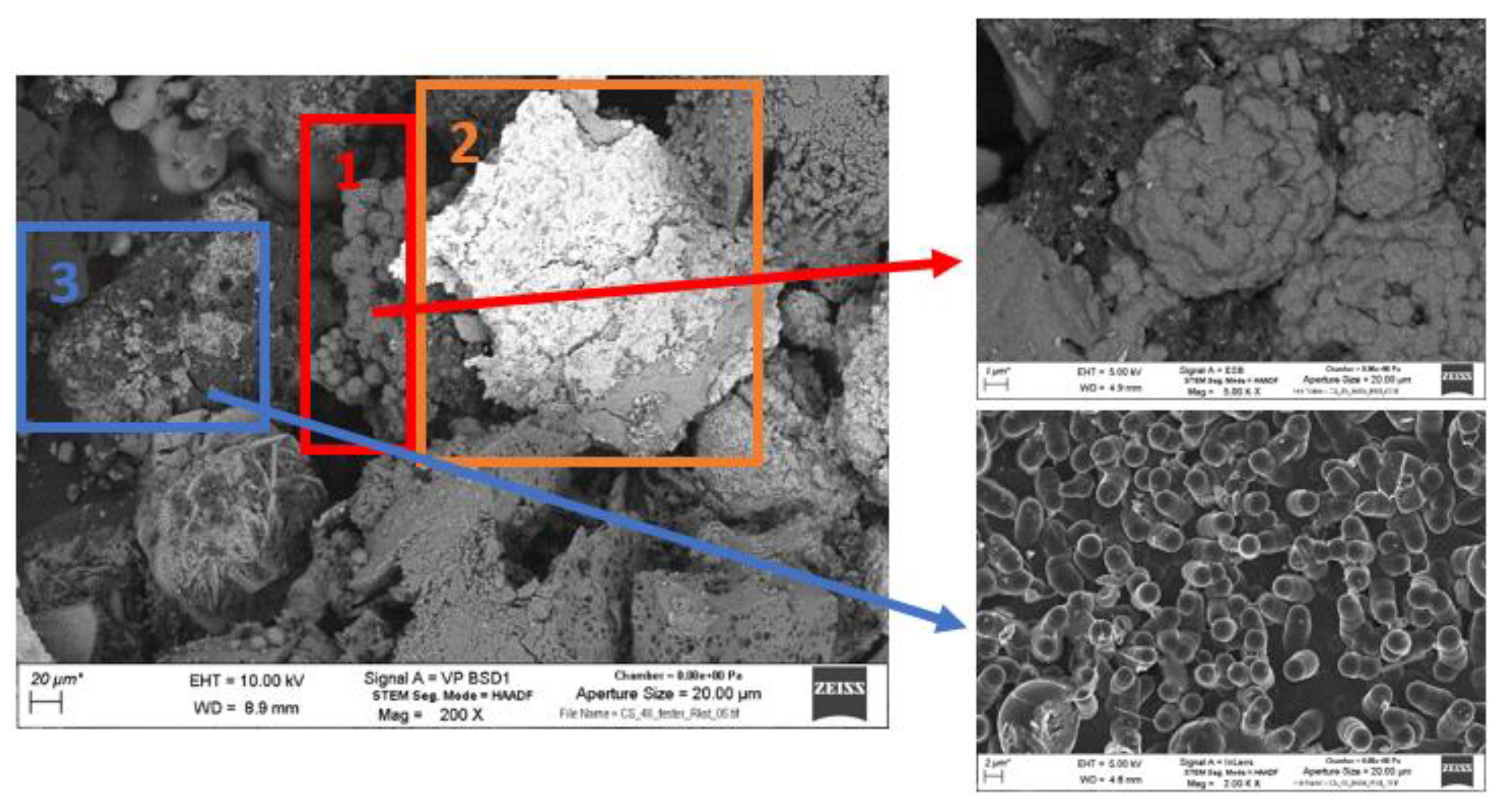
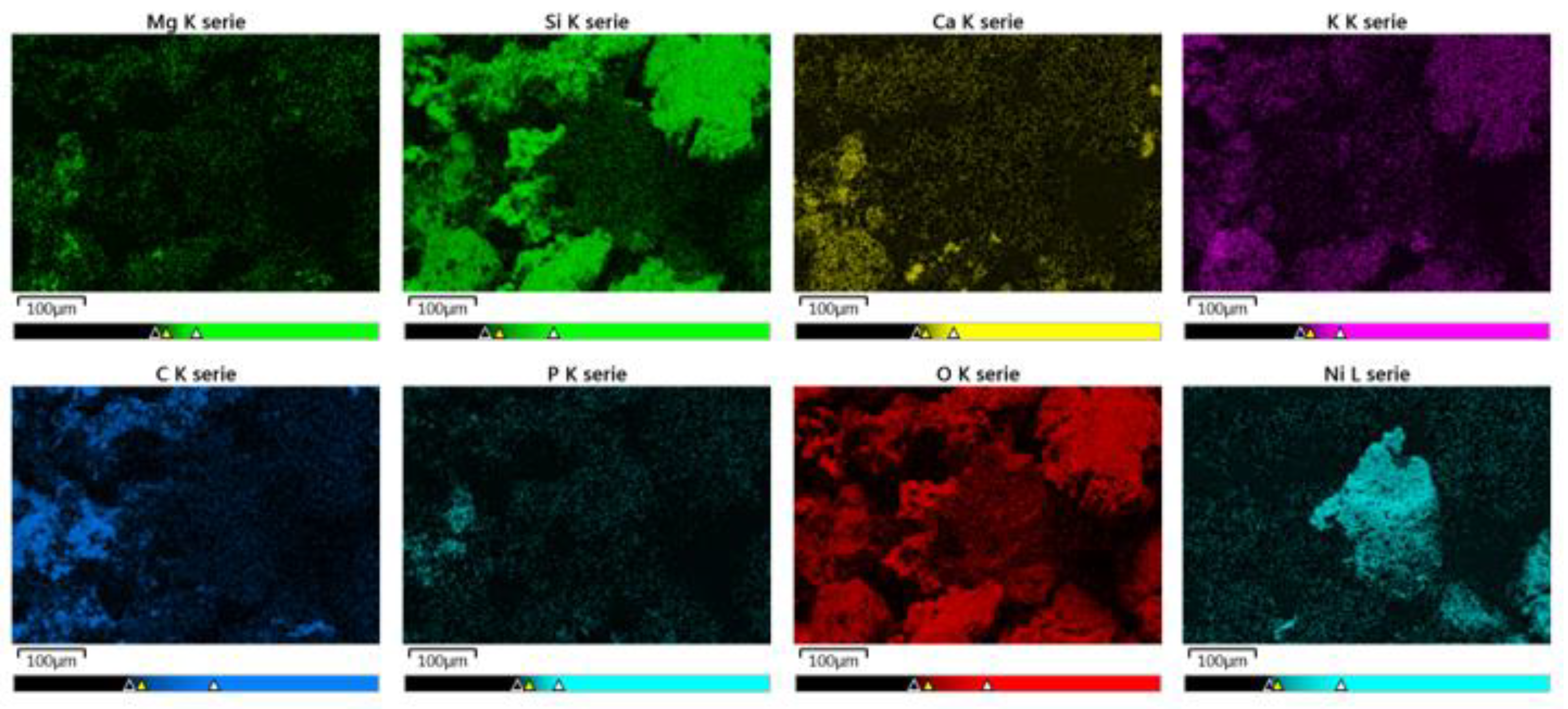
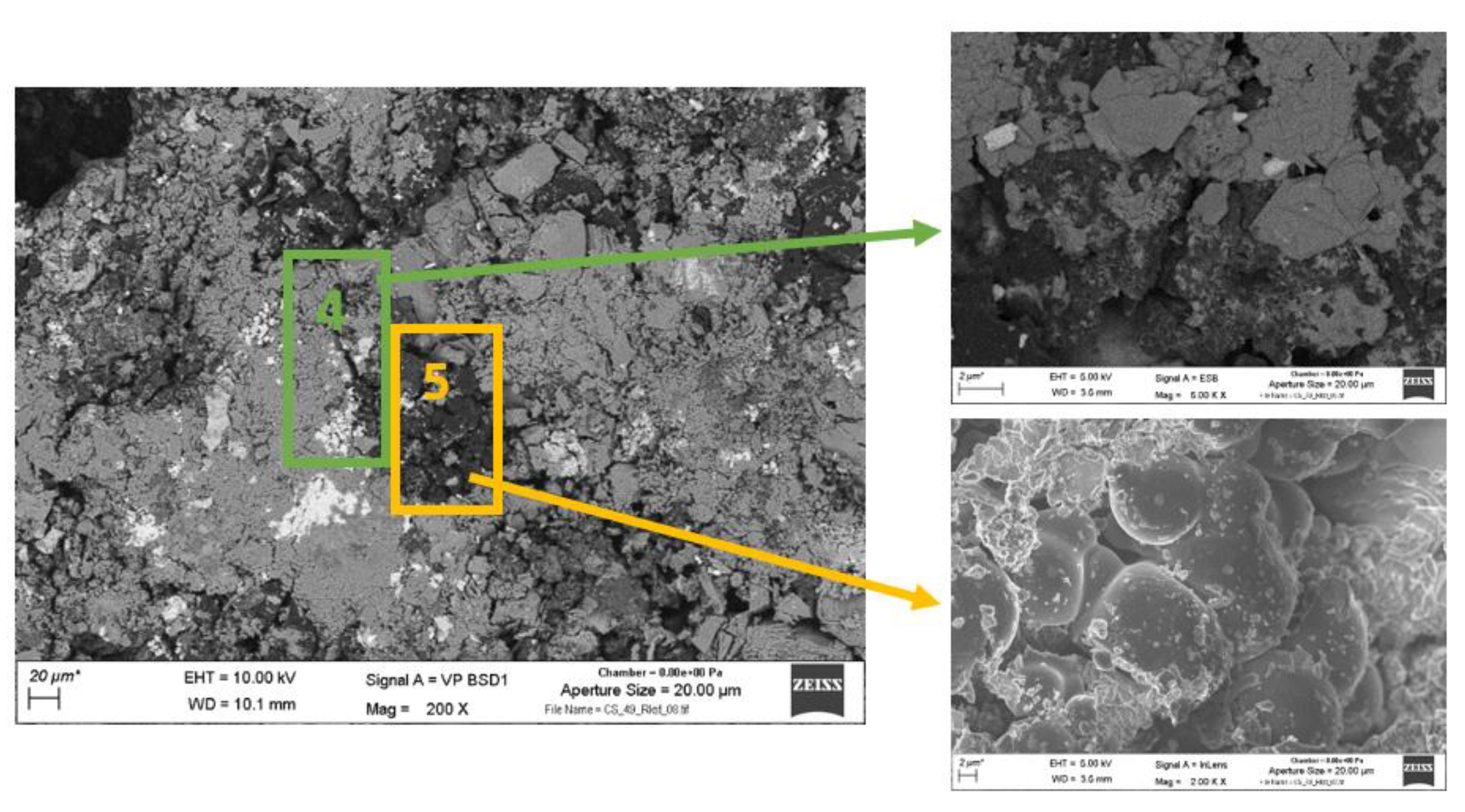
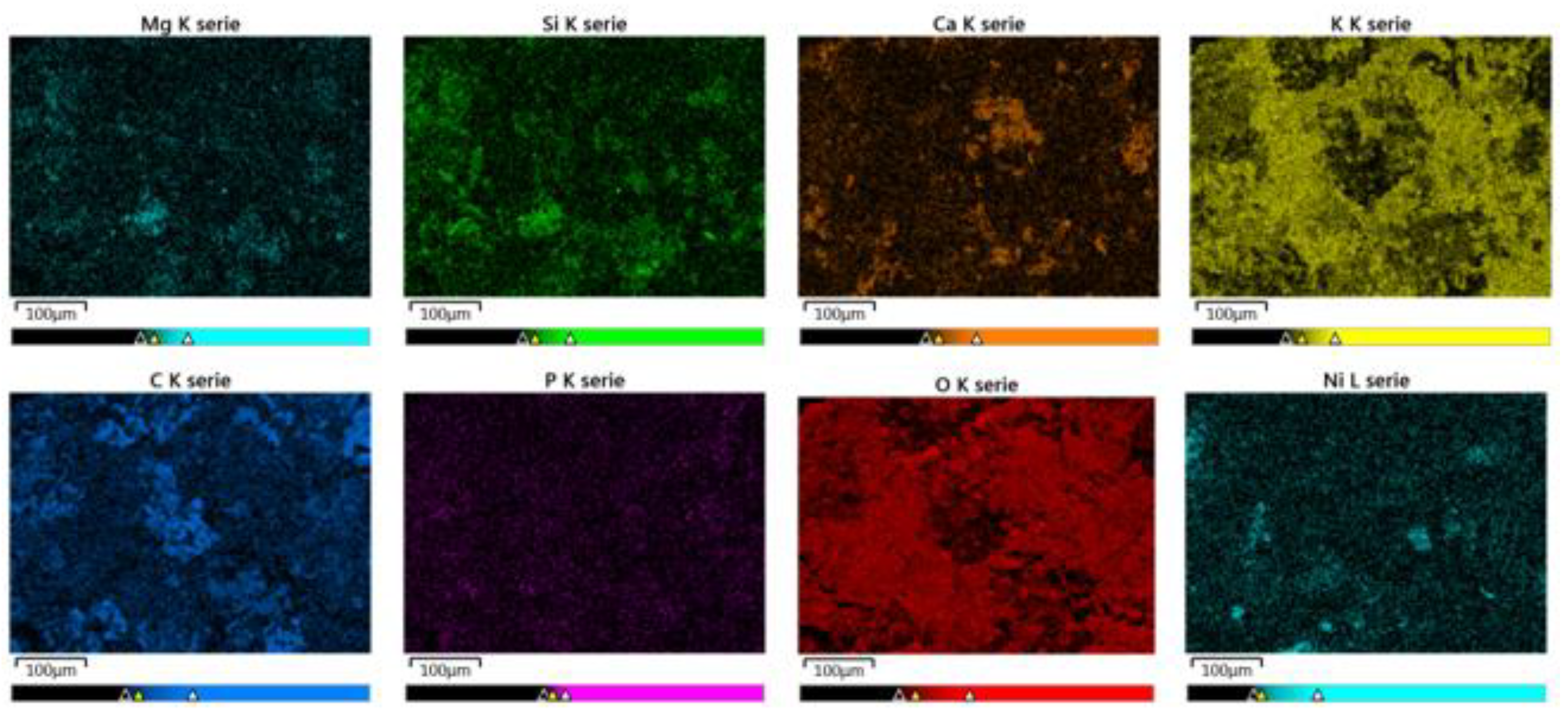
| Biomass | C | O | H | N | S |
|---|---|---|---|---|---|
| Reed Canary Grass | 48.9 | 35.9 | 7.46 | <0.3 | 0.09 |
| Grapevines | 47.1 | 42.8 | 4.47 | 1.2 | 0.003 |
| Experiment Number | Feed | Duration | TPreheater,max | Interval of Salt Separation |
|---|---|---|---|---|
| h | °C | s | ||
| 1 | Reed Canary Grass (8 wt.%) + distilled water | 3.5 * | 460 | 180 |
| 2 | Reed Canary Grass (8 wt.%) + distilled water | 6.5 | 500 | 120 |
| 3 | Reed Canary Grass (8 wt.%) + distilled water | 2.5 * | 500 | 240 |
| 4 | Reactor effluent of 2 | 5.0 | 500 | - |
| 5 | Reed Canary Grass (8 wt.%) + reactor effluent of 1 and 3 | 4.8 | 500 | 120 |
| 6 | Grapevines (8 wt.%) + distilled water | 5.8 | 500 | 120 |
| 7 | Grapevines (8 wt.%) + reactor effluent of 6 | 4.5 | 500 | 120 |
| Experiment Number | Feed | CE % | TOC-Conversion % | TOC Content in Effluent mg kg−1 |
|---|---|---|---|---|
| 1 | Reed Canary Grass (8 wt.%) + distilled water | 67.35 | 89.69 | 3765 |
| 2 | Reed Canary Grass (8 wt.%) + distilled water | 59.14 | 83.83 | 3204 |
| 3 | Reed Canary Grass (8 wt.%) + distilled water | 57.73 | 86.85 | 3230 |
| 4 | Reactor effluent of 2 | 102.73 | 59.32 | 1311 |
| 5 | Reed Canary Grass (8 wt.%) + reactor effluent of 1 and 3 | 55.31 | 86.11 | 3902 |
| 6 | Grapevines (8 wt.%) + distilled water | 55.18 | 86.20 | 3027 |
| 7 | Grapevines (8 wt.%) + reactor effluent of 6 | 51.80 | 86.51 | 3805 |
| Effluent of Experiment | Formic Acid | Acetic Acid | Resorcinol | Phenol |
|---|---|---|---|---|
| 2 | 640 | 57 | 177 | 361 |
| 5 | 742 | 76 | 187 | 618 |
| Effluent of Experiment | Al | Ca | K | Mg | Na | S | Si | Zn | P |
|---|---|---|---|---|---|---|---|---|---|
| 2 | <2 (0.1) | 2.51 | 2180 | <0.8 (0.1) | 46.1 | 20.6 | 75.5 | <0.2 (0.02) | 6.8 |
| 5 | <2 (0.3) | 2.12 | 3850 | <0.8 | 66.2 | 43.4 | 102 | Not detected | 5.8 |
| Effluent of Experiment | Formic Acid | Acetic Acid | Resorcinol | Phenol |
|---|---|---|---|---|
| 6 | 470 | 32 | 178 | 440 |
| 7 | 808 | 121 | 312 | 760 |
| Effluent of Experiment | Al | Ca | K | Mg | Na | S | Si | Zn | P |
|---|---|---|---|---|---|---|---|---|---|
| 6 | <2 (0.06) | <2 (1) | 2430 | <0.8 (0.06) | 33.3 | 4.1 | 26 | n.d. | n.d. |
| 7 | <2 (0.3) | 6.06 | 2840 | <0.8 (0.3) | 31.7 | 6.8 | 15.9 | n.d. | <4 (3.2) |
Disclaimer/Publisher’s Note: The statements, opinions and data contained in all publications are solely those of the individual author(s) and contributor(s) and not of MDPI and/or the editor(s). MDPI and/or the editor(s) disclaim responsibility for any injury to people or property resulting from any ideas, methods, instructions or products referred to in the content. |
© 2023 by the authors. Licensee MDPI, Basel, Switzerland. This article is an open access article distributed under the terms and conditions of the Creative Commons Attribution (CC BY) license (https://creativecommons.org/licenses/by/4.0/).
Share and Cite
Dutzi, J.; Boukis, N.; Sauer, J. Process Effluent Recycling in the Supercritical Water Gasification of Dry Biomass. Processes 2023, 11, 797. https://doi.org/10.3390/pr11030797
Dutzi J, Boukis N, Sauer J. Process Effluent Recycling in the Supercritical Water Gasification of Dry Biomass. Processes. 2023; 11(3):797. https://doi.org/10.3390/pr11030797
Chicago/Turabian StyleDutzi, Julian, Nikolaos Boukis, and Jörg Sauer. 2023. "Process Effluent Recycling in the Supercritical Water Gasification of Dry Biomass" Processes 11, no. 3: 797. https://doi.org/10.3390/pr11030797







